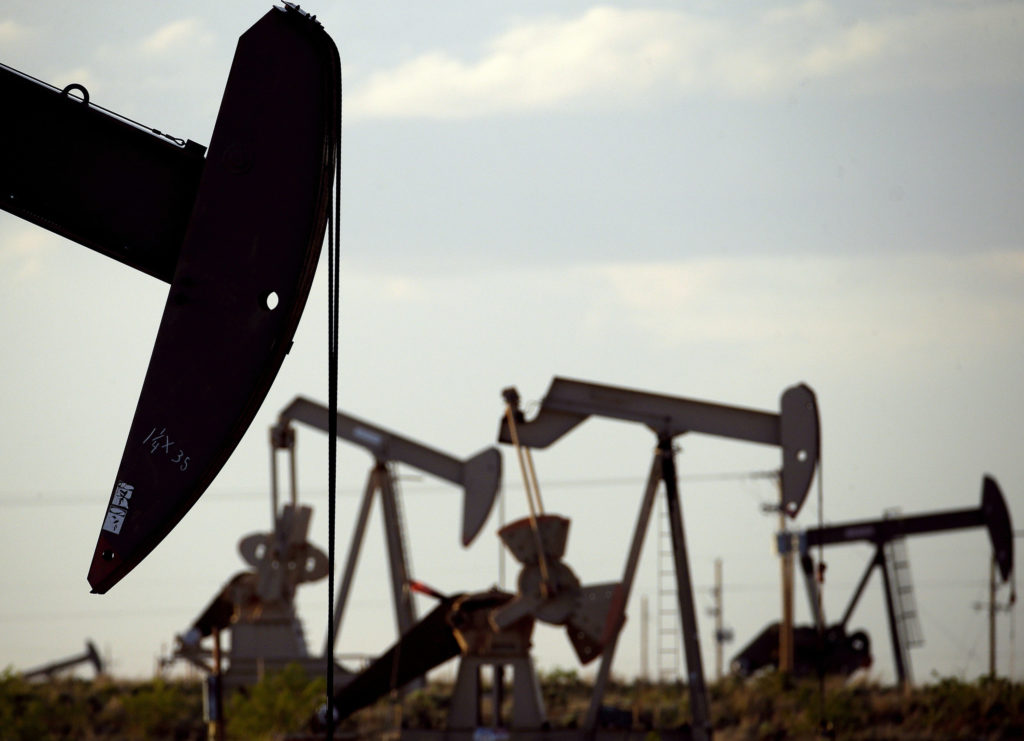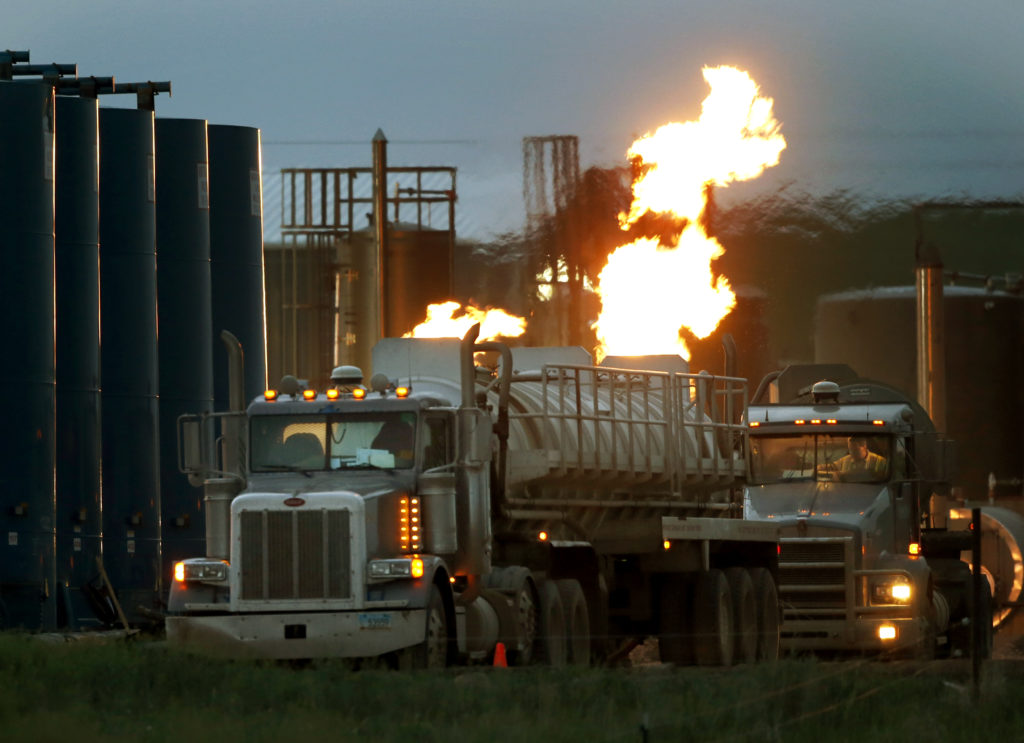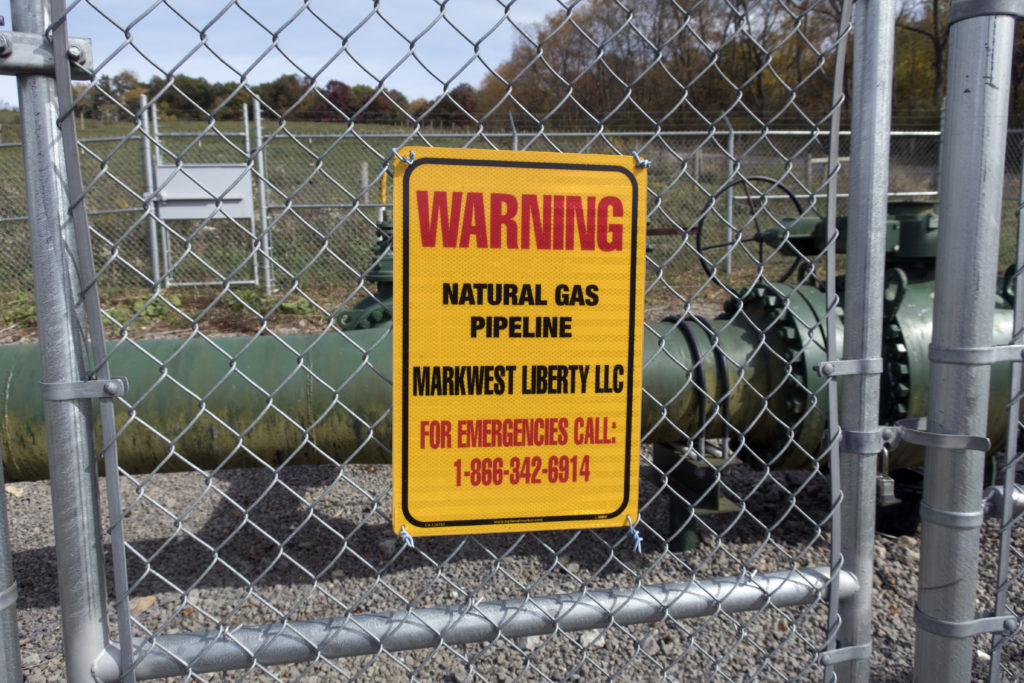 Investigative Stories
Investigative Stories
Growing List of Fracking Concerns Now Includes Radioactivity
Jan 9, 2023 Industry documents and new research suggests the natural gas pipeline system emits significant amounts of radioactivity. FILE - In this April 24, 2015, file photo, pumpjacks work in a field near Lovington, N.M. The Biden administration has approved thousands of drilling permits since taking office despite a campaign pledge to end fracking on federal land. (AP Photo/Charlie Riedel, File)One morning in the fall of 2019, just as the sun was beginning to poke through a layer of overnight fog, a former Army chemist and explosives expert living in Philadelphia named Christina Digiulio set out on her motorcycle, a Harley Davidson Nightster, wearing pajamas under her motorcycle gear and carrying a portable radiation detector called the GQ GMC 500 Plus.
It was humid with a slight breeze as she rode down a slope on Little Conestoga Road in Upper Uwchlan Township, an affluent and generally sleepy Chester County suburb, just west of Philadelphia. She was not riding aimlessly, but headed toward a pump station that had been flaring off emissions from a natural gas liquids (NGL) pipeline.
“My Geiger counter started going crazy,” recalls Digiulio. “It was almost like a cloud was hanging. And I was inhaling it.”
The manual that accompanied Digiulio’s device directed users, who received readings this high that persisted over time, to contact the responsible government agency. But there was nothing to indicate the kind of event the manual likely had in mind, such as the signature of a dirty bomb attack or a nuclear power plant leak. It was a peaceful morning among suburban homes with swimming pools and occasional farm fields. It seemed like the only possible source for such high levels of radiation was the pump station, a small industrial plot of pipes, valves and featureless buildings near the top of a long rolling hill.
At the time of Digiulio’s unusual radiation experience, America’s fracking boom was roaring into its third decade. Although fracking requires the use of explosives and a long list of toxic, often secret chemicals to crack oil and gas out of hard-to-reach formations, its promoters assured communities that it was safe. “I’m requiring all companies that drill for gas on public lands to disclose the chemicals they use,” President Barack Obama declared in his 2012 State of the Union Address. “America will develop this resource without putting the health and safety of our citizens at risk.”

Digiulio is among a growing group of Americans who have learned that fracking is not safe and raises a number of safety and health concerns that we are still only beginning to fully comprehend. The use of secret chemicals has riled the medical community and poses unknown contamination risks to oilfield workers. Methane emissions contribute to the climate crisis. The reinjection of oilfield waste leads to earthquakes and contaminates property. To this list we can add Digiulio’s discovery in 2019, now part of a body of growing and ominous evidence, that fracking produces enormous radioactivity emissions.
“If you asked me to go and live downwind [of fracking sites], I would not go,” Petros Koutrakis, an environmental scientist at the Harvard T.H. Chan School of Public Health, told the Guardian in 2020, after his research team published a scientific article revealing airborne radioactivity increased downwind of fracking sites. “People should not go crazy,” Koutrakis stated, “but I think it’s a significant risk that needs to be addressed.”
To this list we can add Digiulio’s discovery in 2019, now part of a body of growing and ominous evidence, that fracking produces enormous radioactivity emissions.
One of the more concerning suspected locations of release are the myriad pump stations and compressor stations that have popped up along the nation’s sprawling natural gas pipeline system. These are necessary to keep pressure in pipelines containing NGLs and natural gas, as these fuels are piped out of America’s gas-rich fracked formations, such as the Eagle Ford Shale and Permian Basin in Texas, and the Marcellus and Utica formations in northern West Virginia, eastern Ohio and Pennsylvania, bound for use in fueling East Coast and Midwest cities and home stoves, transport as liquified natural gas across oceans to gas-hungry Europe and Asia or as feedstock for the plastics industry.
While pipeline safety is regulated by the Pipeline and Hazardous Materials Safety Administration (PHMSA), environmentalists and Congress have regularly criticized the agency. “Unfortunately, federal safety regulators fail to do their jobs when it comes to pipeline safety,” Sen. Ed Markey (D-Mass.) stated at a Senate hearing in November 2018. “The agency is the poster child for an agency that has been captured by the industry it is supposed to regulate. Rather than being a watchdog it has become a lapdog.”
The Mariner East 2 pipeline network that Digiulio was investigating transports NGLs from the Marcellus-Utica across the state of Pennsylvania to a port on the Delaware River. For years, activists have been battling industry and regulators about the thousands of tons of methane and known carcinogens like benzene that are leaked, flared and released from compressor stations and pump stations during events known as “blowdowns” — necessary pressure adjustments that purge pipeline contaminants directly into the air and onto the land of adjacent farms and communities.
Digiulio’s discovery on that fall morning in 2019 followed a tip from locals living along the Mariner East 2 that flaring was expected to purge the pipelines of contaminants. Knowing that the natural gas and NGLs flowing through the nation’s pipeline network also contain the radioactive gas radon—initially brought to the surface with the hydrocarbons and unable to be removed by generally followed treatment processes—she suspected the blowdown might include radioactive releases. Recently publicized oil and gas industry documents — brought to light by my own reporting — corroborate these concerns and suggest that the industry has had knowledge for decades that the releases may also contain radioactivity.
A major breakthrough occurred in the spring of 2021. Just a year-and-a-half after her early morning motorcycle ride, Digiulio led the world-renowned radon expert, Dr. Mark Baskaran of Wayne State University, along with one of this his graduate students, Bobby Manion, on a tour of compressor stations and other oil and gas infrastructure across the region. Joining them was Lois Bjornson, who gives “frack tours” to journalists as a field organizer with a Pennsylvania-based group called the Clean Air Council, the southwestern Pennsylvania environmental watchdog Mountain Watershed Association, University of Pittsburgh radiation oncologist Dr. Marsha Haley and members of the Pennsylvania chapter of Physicians for Social Responsibility, a national health and environmental advocacy group. It was a science team I helped organize; after two years the results are finally in and Baskaran and Manion are looking to publish in the Journal of Environmental Radioactivity later this year.
“What we have found,” says Baskaran, who scoured the scientific literature on oilfield radioactivity in preparing the research, “is that the oil and gas industry produces an enormous amount of radioactivity.”
On the research field trip undertaken in the spring of 2021, Baskaran’s team gathered samples at homes that have had oil and gas development on the property, homes near landfills that are accepting significant amounts of oilfield waste and homes near natural gas and NGL pipelines. But the results that may hold the most meaning for those pressing to hold the oil and gas industry accountable may be the set of soil samples the team took at the fenceline of the Eagle Compressor Station. It’s located in Chester Springs, Pennsylvania, a northwestern suburb of Philadelphia, and less than 200 feet from the Fellowship Fields, a community recreation area that contains football, lacrosse and soccer fields. Baskaran says the calculated radiation dose from the elevated levels of radioactivity observed in a few sites is below the annual dose limit of 0.05 Sv (or 5 rem) for radiation workers.
“What we have found,” says Baskaran, who scoured the scientific literature on oilfield radioactivity in preparing the research, “is that the oil and gas industry produces an enormous amount of radioactivity.”
“We can say that compressor stations, based on our numbers, do appear to elevate radioactivity,” said Manion, Baskaran’s graduate student. “We certainly want to look further at compressor stations across this region and the nation to see if levels are elevated elsewhere or even higher in some places.”
Background levels of lead-210 and polonium-210 are generally around 1 to 2 picocuries per gram but at the Eagle Compressor Station, the scientists took eight samples and found levels consistent with lead-210 measuring as high as 3.95 and polonium-210 as high as 3.14 picocuries per gram. Radium levels, often around 1 picocurie per gram in background soil, were also consistently elevated and recorded as high as 4.05 picocuries per gram. “Often in surface soil, higher levels of polonium-210 and lead-210 are found due to atmospheric deposition (atmospheric radon decaying to lead-210 that are subsequently removed by precipitation and delivered to surface earth),” says Baskaran. “Elevated levels in deeper layers of soil cores likely indicate impact oil-related activities.”
Energy Transfer, the Texas-based company that owns the Mariner East 2 pipeline, has not replied to questions concerning radioactivity in their NGL and natural gas pipeline systems.
* * *
A trail of oil and gas industry reports details radioactivity accumulations and emissions in the natural gas pipeline system. Oil and gas production brings to the surface an extremely salty and toxic fluid known as oilfield brine, or produced water, which typically contains elevated levels of heavy metals, including the radioactive metal radium. Tanks and trucks that hold and transport brine can accumulate a sludge that contains even more concentrated levels of radium, and my reporting has shown this radioactivity can dangerously accumulate on worker’s clothes and bodies. However, the concern in natural gas and NGL pipelines is the radioactive gas radon.
Radon is produced with natural gas at the wellhead and travels freely through the pipeline system. All radioactive elements eventually decay, meaning they give off a burst of radiation, losing a small piece of themselves to become another element. Radon-222 decays relatively quickly, after a matter of days or weeks, becoming the radioactive element polonium, which in turn will continue to fire off radiation, transforming into radioactive forms of lead, bismuth and other isotopes of polonium. It is these radioactive metals that stick to the inside of natural gas pipelines, and also accumulate on various pumps, valves and filters inside the pipeline systems. If there are emission points along the pipeline system, explains Baskaran, then the radioactive gas radon, along with lead-210, bismuth-210 and polonium-210, will likely be emitted too.
The radioactive sludge that builds in pipelines may be contaminated with radioactive lead and polonium, with some of this waste so radioactive it “must be handled as low-level radioactive waste and disposed of accordingly,” according to a 1993 article written by industry consultant Peter Gray in the Journal of Petroleum Technology, the flagship publication of the Society of Petroleum Engineers, one of the industry’s most prestigious professional groups. In 2019, another industry consultant, Alan McArthur, provided a presentation to a group of government experts known as the Conference of Radiation Control Program Directors on the dangers of radioactivity in the natural gas pipeline system. He listed risks to industry workers and the environment, and advised that “respiratory air and public air monitoring should be required on all” projects involving natural gas infrastructure.

The concern is not specific to Pennsylvania—it permeates the entire nation. Crisscrossing America are 321,000 miles of natural gas transmission and gathering pipelines, with valves, pumps, filters, and certain bends and edges continuously coated in radioactive scale and sludge.
How radioactive is this sludge? How much of it is out there? How is it all cleaned out? Where is it disposed?
The two main agencies responsible for regulating pipelines — the Federal Energy Regulatory Commission and the Pipelines and Hazardous Materials Safety Administration — have no clue. They are not checking for radioactivity emissions from pipelines and gas infrastructure before issuing permits companies must acquire before building these systems. This denies the American public the knowledge that the problem exists, thus preventing them from raising awareness and concern about the issue in comments on projects and at public meetings.
Compressor stations exist in every state. They are regularly located beside parks, busy roadways, commercial centers and residences. In Pennsylvania, a compressor station can be located as close to 750 feet from a home or school. “Emissions occur continuously during normal operations, as hazardous pollutants carried with the gas are vented or leak from equipment,” says the Southwest Pennsylvania Environmental Health Project, an advocacy group of nurses and health professionals. “These toxics can be carried downwind from the compressor station to residents in surrounding areas, impacting people living within a six mile radius of the compressor station or, in some cases, a greater distance, depending on weather conditions and terrain.”
For the last decade, environmentalists have occupied treetops, cornfields and entire communities to fight fossil fuel pipelines. Perhaps no fight has been more hotly contested than the Mountain Valley Pipeline, a proposed project to take fracked gas from an especially gas-rich quadrant of the Marcellus Shale in northwestern West Virginia, across the spine of the Appalachian Mountains, under the Appalachian Trail, through the heart of Virginia and into North Carolina. The pipeline has been vigorously resisted by a broad and diverse coalition of West Virginians and Virginians, and remains mired in legal challenges, despite the continued efforts of Sen. Joe Manchin (D-WV) to ram its approval through Congress.
“It became clear to us early on that the Virginia Department of Environmental Quality’s role was actually to facilitate completion of this destructive and dangerous infrastructure,” says Tina Smusz, a retired emergency medicine and palliative care physician and Virginia-based member of Physicians for Social Responsibility.
The two main agencies responsible for regulating pipelines — the Federal Energy Regulatory Commission and the Pipelines and Hazardous Materials Safety Administration — have no clue. They are not checking for radioactivity emissions from pipelines and gas infrastructure before issuing permits companies must acquire before building these systems.
“Sadly, they appear to have taken no interest in this serious issue,” she continued. “On one memorable occasion I asked members of the local gas company specifically about the radiation hazards associated with the station’s operation and maintenance, expressing my concern for the people in the neighborhood as well as the future maintenance workers. The gas company representatives dived quickly for their phones, looked blankly at each other and responded vaguely that it was not an issue.”
Furthermore, adds Smusz, “the specter of a 300-mile long radioactive Superfund site traversing two states through perpetuity has not been addressed by the Federal Energy Regulatory Commission, or FERC,” which regulates interstate gas pipelines. Indeed, when FERC reviews pipeline projects, compressor stations are included in the review, and emissions must be reviewed under the Clean Air Act, but radioactive emissions are not included as part of this review.
FERC has passed off my questions on the issue of radioactivity in the pipeline system to other agencies. And PHMSA has not replied to specific questions on this topic.
“I suspect that substantive data like this would improve our ability to mobilize more citizens to protest and hopefully prevent these harmful projects,” says Smusz.
“People, in general, have a healthy fear of anything radioactive, and that fear may help tip outcomes in the favor of protecting our communities.”